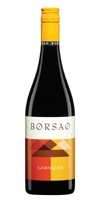
External search
Google (images)
Wine Advocate
Wine Spectator
Burghound
Wine-Searcher
Vintages
2022
2021
2020
2019
2018
2017
2016
2015
2014
2013
2012
2011
2010
2009
2008
2007
From this producer
Show all wines
All tasting notes
|
| Drinking Windows and Values |
| Drinking window: Drink between 2011 and 2014 (based on 17 user opinions) |
| Community Tasting History |
| Community Tasting Notes (average 85 pts. and median of 86 pts. in 6 notes) - hiding notes with no text | | | Tasted by mjwstickings on 8/12/2016 & rated 86 points: Compared to other reds in the Borsao range (e.g., the popular Tres Picos), this blend of Garnacha (70%), Syrah (20%), and Tempranillo (10%) is thankfully, and enjoyably, non-confected. In other words, it's not forced to be what it's not, and that may be due in large part to the Syrah, which imparts meaty and spicy black pepper notes. There's too much meatiness, and too much meaty funk, but the black pepper combines with green pepper to complement the cherry, dark berries, and vanilla (there's oak here, but, as with the confection, it's kept well in check compared to other Borsaos). It's drinking well now, soft and approachable, the fruit starting to dry out, and while it certainly lacks depth, complexity, and elegance, and while the notes are out of balance, it's a rather nice basic Spanish blend that benefits from the Syrah. (555 views) | | | Tasted by forecaster on 5/30/2012 & rated 84 points: Cheap and cheerful wine. It has a bit of grip which gives it a bit more interest than most wines in this price range. (1292 views) | | | Tasted by Samsara on 10/21/2011 & rated 81 points: À détailler (1319 views) |
| Bodegas Borsao Producer website
U.S. Importer (Addt'l Info)Bodegas Borsao Campo de Borja Selecciónhttp://bodegasborsao.com/borsao-tinto-seleccion-5/Grenache Blend. Spain Vinos de España - Wines of Spain (Instituto Español de Comercio Exterior) | Wikipedia
Wine Map on weinlagen-info
Spain is the third largest wine producing nation in the world, occupying the majority of the Iberian Peninsula with vast diversity in climate, culture, and of course, wine. From inky, dark reds of the [Priorat] to dry, white Finos from Andalusia, Spain can easily boast of elaborating a wide variety of notable styles. Within Spain there are currently 62 demarcated wine regions, of which a handful have gained international recognition: [Rioja], Priorat and [Ribera del Duero]. Yet these regions are only a small sample of the high quality wines Spain produces. Regions such as Cava, Penedes, Somontano, Galicia, Rueda and Jerez are only a few of the numerous regions worthy of exploration throughout Spain. Spain can also lay claim to having the most land under vine in the world, growing up to, by some accounts, 600 indigenous varietals of which Tempranillo is their most well known. Other popular varietals include [Garnacha], Bobal and Monastrell for reds and for whites; the infamous [sic] Palomino Fino grape which is used in the production of sherry wine, Pedro Ximenez in Montilla Morilles, Albarino used in the creation of the bright, effervescent wines of Galicia, and Verdejo in Rueda. - Source: - Catavino.net
Spain is not in the forefront of winemaking for its dessert wines, other than for its sweet wines from Sherry country including the highly revered Olorosos (when sweetened). But apart from Sherry Spain has a range of styles of dessert wines, ranging from the those made from the Pedro Ximenez grape primarily in Jerez and Montilla-Moriles) to luscious, red dessert wines made in the Mediterranean from the Garnacha (Grenache) grape. Some good Moscatels are made in Mallorca, Alicante and Navarre. The northwest corner of Spain, Galicia, with its bitter Atlantic climate, is even making dessert wines, called “Tostadillos” in the village of Ribadivia (similar to France’s “Vin de Paille”). The Canary Islands have made interesting dessert wines for centuries (they are mentioned by Shakespeare, for example) and in recent years the quality of winemaking has been improved and the Canary Islands wines are being better marketed now. The winemaking styles for “Vinos Dulces” are also diverse, from “Late Harvest” (Vendimia Tardía) to “Fortified Wines” (Fermentación Parcial). Based on in-spain.info.Aragón Aragon (wikipedia)Campo de Borja DO Campo de Borja
Campo de Borja is een streek die in het westen ligt van de regio Aragón en geografisch gezien is het een voortzetting van zuid Navarra. De wijngaarden staan op een hoogte van 350 tot 700 meter in een bodem die vooral bestaat uit bruine, zanderige aarde en kalksteen. Dit bodemtype bevordert de drainage en is rijk aan calcium en silicium. Ideaal voor het produceren van kwaliteitswijnen. Het klimaat in Campo de Borja is continentaal. Hete zomers, koude winters en maar weinig neerslag. Gelukkig maakt de wintermist veel goed. Wijngaarden in deze regio bestaan vaak uit de druivensoort Garnacha. Tegenwoordig wordt deze ook aangevuld met Tempranillo en Cabernet Sauvingon. Campo de Borja heeft een D.O. status sinds 1980.
|
|




